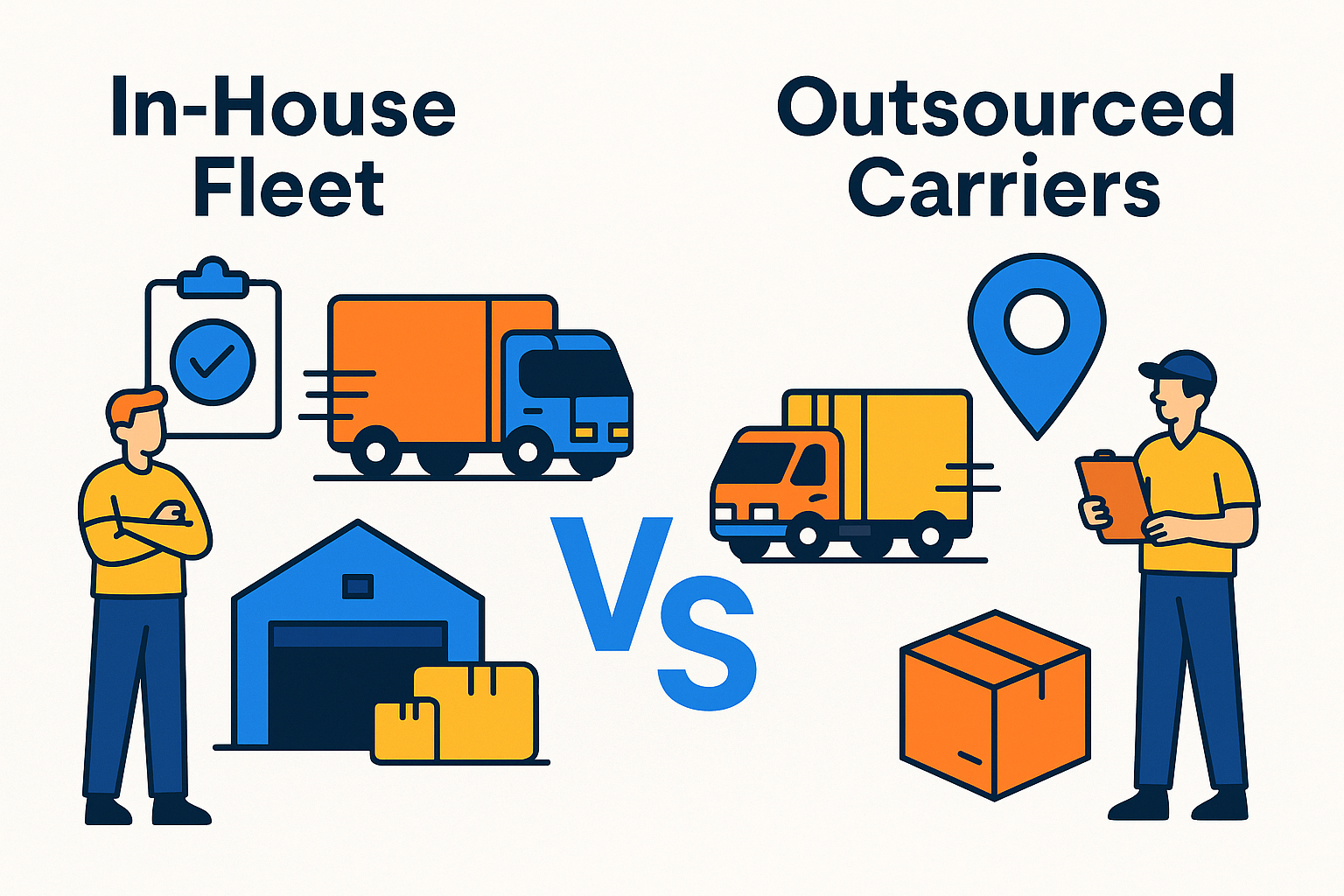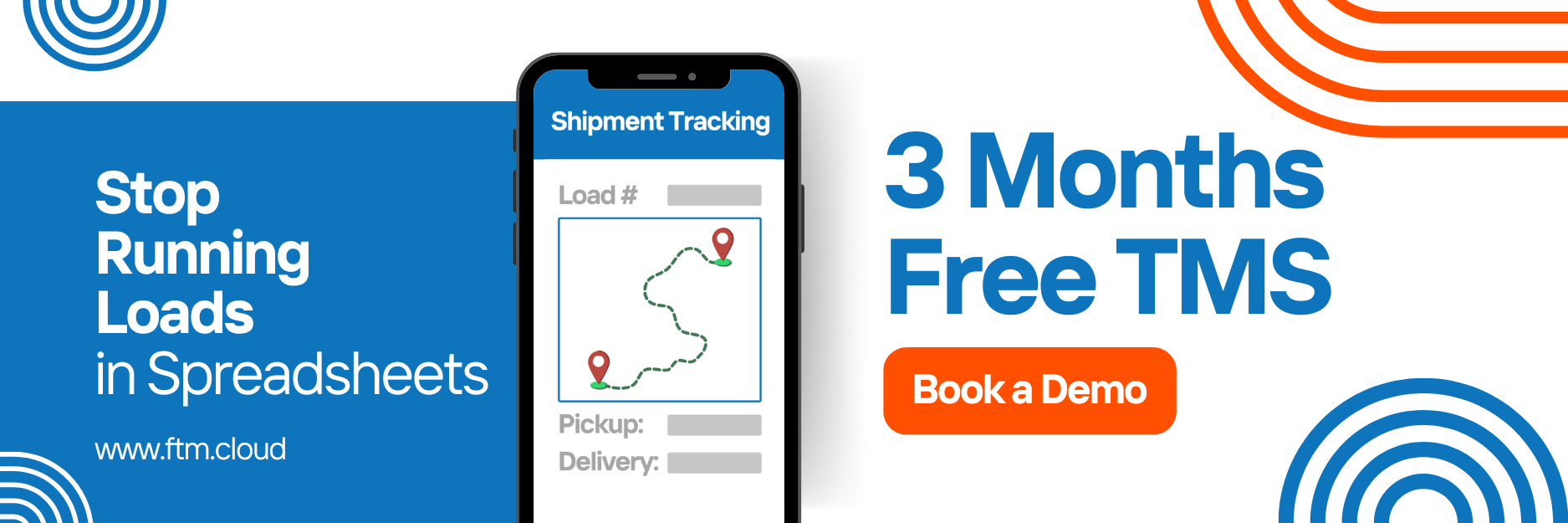Explore the pros and cons of in-house fleets vs outsourced carriers. Discover which model scales better for cost, control, flexibility, and growth.
The Growth Dilemma in Logistics
The growth of logistics usually raises an essential question for shippers and brokers: do you scale by growing your own in-house fleet, or should you outsource more to third-party carriers? Everything offers potential, but there are trade-offs on cost, control, risk and flexibility. Trends from 2023-2025 highlight the fact that organizations that can couple this decision with the visibility tools, risk, and a strong partner network will bring about the most sustainable growth.
Understanding the Two Models
| Model | What It Means | Key Advantages | Common Challenges |
| In-House Fleet | Owning or leasing your own trucks/trailers, managing drivers, maintenance, scheduling. | More control over operations, brand consistency, better asset utilization in stable demand. | High upfront fixed costs, maintenance burden, regulatory/compliance complexity, under‐utilization during fluctuations. |
| Outsourced Carriers | Relying on external carrier networks or brokers to haul freight. | Flex capacity quickly, lower fixed overhead, leverage external expertise. | Less control, variable service consistency, risk of dependability, margin pressures. |
What Recent Data Tell Us (Recent Trends)
- Fuel and Maintenance Costs Rising: After 2022-2023 fuel price volatility, owning vehicles has become much costlier on maintenance and regulatory compliance. Outsourced carriers may absorb some of that risk.
- Driver Shortage & Turnover: High attrition among drivers (often above 25% annually in many U.S. fleets) increases cost and complexity for in-house fleets. Outsourcing gives access to broader driver pools.
- Technology Gains: Visibility tools (real-time GPS, predictive maintenance, route optimization) are leveling the playing field; even in-house fleets need robust TMS to match flexibility and efficiency of carriers.
- ESG Pressure: Investors and customers increasingly expect sustainability reporting. Outsourced carriers with greener trucks or electric capabilities may offer an advantage.
Read more: Why Are Truck Drivers Quitting? How Fleets Can Reduce Turnover in 2025
Which Scales Better By Dimension
1. Cost Scalability
- In-house fleet: Fixed costs (vehicles, insurance, maintenance). Scaling requires capital investment. During slack demand, assets sit unused.
- Outsourced carriers: Variable costs; you pay per load/mile. Better for scaling up/down rapidly.
Takeaway: For companies with predictable, high volume in stable lanes, in-house can become more cost-efficient. But variable demand favors outsourced capacity.
2. Operational Control & Brand Reliability
- In-house allows consistent service quality, control over equipment, driver training, and branding (especially for last mile or high‐value shipments).
Outsourced carriers bring variability; need strong partner vetting, contracts, and performance KPIs.
3. Flexibility & Responsiveness
- When unexpected disruptions hit (e.g., weather, trade delays, port congestion), outsourced carriers offer more agility. You can shift to alternative carriers without maintaining idle assets.
- In-house fleets shine where control over timing, customer experience, or specialized equipment matters (e.g. temperature control, hazardous materials).
Read more: ChatGPT Prompts Every Carrier Should Use to Solve Logistics Challenges
4. Technology & Scalability
- Scaling either model demands strong technology: TMS with load optimization, real-time tracking, exception management, route optimization.
Outsourced carriers are increasingly offering their own tech, but alignment of systems is essential.

Practical Strategies to Maximize Scaling Success
| Strategy | For In-House | For Outsourced Carrier Model |
| Optimize Asset Utilization | Use route planning, backhaul matching, and reduce empty miles. | Negotiate with carriers for shared rates, capacity pools. |
| Invest in Visibility | Implement real-time tracking, dashboards for detention, delays. | Require carriers to provide visibility, use shared dashboards, PODs. |
| Flexibility in Contracts | Lease vs. own decisions, maintenance plans, flexible utilization models. | SLA clauses, service warranties, performance penalties/rewards. |
| Sustainability Integration | Introduce electric/hybrid vehicles, monitor carbon per mile. | Partner with carriers who meet environmental credentials. |
Key Considerations Before Deciding
- Volume predictability: Is your freight volume steady or fluctuating?
- Capital availability: Can you afford trucks, insurance, maintenance, compliance?
- Risk tolerance: Are you willing to handle driver shortages, repairs, regulatory burden?
- Technology readiness: Do you have or can you adopt the TMS and visibility tools needed to track, analyze, and optimize either model?
The Role of TMS & Visibility Tools
Whatever model you choose, scaling well demands visibility and real-time data. Effective Transportation Management Systems help you monitor empty miles, manage exceptions, track carrier performance, and control costs. The best operators use TMS dashboards, route optimization, and KPIs to make both in-house fleets and carriers perform like lean, scalable assets.
Read more: Dispatch Console: Boost Logistics for Shippers, Brokers & Carriers
Which Path Scales Best: The Verdict
If your operation has predictable high-volume lanes, domain-specific requirements, or regulated shipments, scaling an in-house fleet provides control, reliability, and leveraging assets long-term. If you operate in quickly changing markets with unpredictable demand or don’t want to heavily invest in assets to scale quickly, outsourced carriers provide flexibility and reduced risk.
Many prominent logistics teams leverage a hybrid model: an in-house fleet with operational focus for your core high-value or dedicated lanes, augmented with outsourced carriers to provide service for overflow, peak season, or irregular routes, or geographic areas.
Take Action Today
To scale smartly, you need data, visibility, and flexibility. If you’re evaluating whether to grow in-house or lean on carriers, consider tools that give you real-time performance, cost transparency, and route optimization. Try FTM to centralize your decisions, evaluate carrier vs fleet ROI, and build a scalable logistics strategy for the future.

